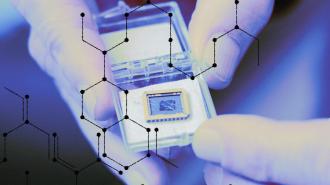The world’s first functional graphene semiconductor outperformed one made of silicon — suggesting that the supermaterial could be the future of computing.
The background: A material can be classified by how well it conducts electricity. If electrons flow easily through it, it’s a “conductor”; if they don’t, it’s an “insulator.” Between the two are “semiconductors,” materials that can conduct electricity well, but only under specific conditions.
That property has made semiconductors the backbone of computing — by making microchips from the semiconducting material silicon, we can easily control when electricity does or does not flow through them, giving us a way to “speak” to computers in their language of 1s and 0s.
A graphene semiconductor: We’re starting to reach the limits of what silicon can do in computer chips, though, and in the hunt for alternatives, a team led by Georgia Tech physics professor is looking closely at graphene, a super-strong two-dimensional form of carbon.
“We were motivated by the hope of introducing three special properties of graphene into electronics,” said de Heer. “It’s an extremely robust material, one that can handle very large currents, and [it] can do so without heating up and falling apart.”
The problem is that graphene isn’t a semiconductor — not naturally, anyway.
“It’s like driving on a gravel road versus driving on a freeway.”
Walter de Heer
What’s new? Through past research, de Heer’s team discovered how to grow graphene on wafers of silicon carbide, and through years of refinement, they figured out how to get that graphene to demonstrate semiconducting properties.
For their latest study, published in Nature, they demonstrated how they could “dope” their graphene semiconductor with atoms to create a transistor, one of the switches or gates that controls the flow of electricity in a chip.
“Our motivation for doing graphene electronics has been there for a long time, and the rest was just making it happen,” said de Heer. “We had to learn how to treat the material, how to make it better and better, and finally how to measure the properties. That took a very, very long time.”
According to their testing, electrons flowed through the graphene semiconductor more easily than one made of silicon, which suggests the approach could lead to faster computers.
“It’s like driving on a gravel road versus driving on a freeway,” said de Heer. “It’s more efficient, it doesn’t heat up as much, and it allows for higher speeds so that the electrons can move faster.”
Looking ahead: The electronics industry isn’t going to drop silicon for graphene (or any other material) overnight, and performance isn’t the only consideration when they do make a change — cost, durability, ease of manufacturing, and more will all play a role.
Still, de Heer is confident that, when the next major shift in electronics does happen, graphene will be at the center of it.
“Graphene is the next step,” he said. “Who knows what the step’s going to be after that, but there’s a good chance that graphene can take over and be the paradigm for the next 50 years.”
We’d love to hear from you! If you have a comment about this article or if you have a tip for a future Freethink story, please email us at [email protected].





